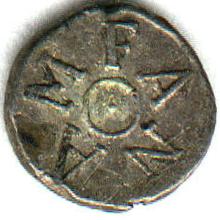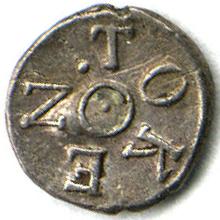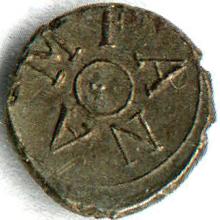1815 - Ceylon
Fanam - Token
Struck locally and declared current by a British Government notice
dated 16 July 1814. The silver fanam tokens, 16 of which
intrinsically worth a rix-dollar to pass current at 12 to the
rix-dollar. Minting continued until September 1815.
| SPECIFICATIONS |
| Denomination | One Fanam |
| Alloy | Silver.833Ag |
| Type | Struck |
| Diameter | 8.7 mm |
| Thickness | mm |
| Weight Legal | 0.56 gms |
| Weight | 0.5 gms |
| Shape | Round |
| Edge | Plain |
| DieAxis | O° |
| Issue | 2,400,000 |
| Mint | Ceylon |
|

|

|
| Codrington #156 |
| Diameter | 8.7 mm |
| Thickness | mm |
| Weight Legal | 0.56 gms |
| Weight | 0.6 gms |
| DieAxis | O° |
The coin above has a clear dot at center of TOKEN side
which does on appear on the higher grade specimen on
the right. This is listed as a minor variety in the 3rd
Edition of Krause.
|

|

|
| KM#83 ; Mitchiner #2216 |
Obverse : A dot at the center and the legend
FANAM within two line circles.
Reverse : A dot at the center and the legend TOKEN.
The image of token shown on the upper panel and that in Codrington has
a dot within center circle on reverse. On the token on the lower panel
images shown in Krause, Mitchiner this central
dot is not seen. I have also seen other specimens of both types.
Jan Lingen explains the dot at center of some Ceylon
coins
``When cutting the dies often a centre point is used for marking
the circular legend and outer borders. Once the punches for the values
are added the centre point usually disappears while on some other
varieties the centre point is very clear.In my opinion all the coins
were initially designed with the use of a centre point, but by filling
in the design this point disappeared.
In 1814, the scarcity of silver and copper coins was causing the
Government great concern. The Governor, after speaking of the
inconveniences resulting from the scarcity stated,
"no better
expedient has presented itself than that of following the measure
lately adopted in the Mother Country of issuing tokens".
Since the tokens supplied a real want they remained in
circulation. These tokens were receivable at the Treasury and at all
Kachcheries. The introduction of the tokens also helped curb the
export of coins and the return of private hoards of coins back into
circulation.
In the past a coin was a "Token" if it was valued at more than the intrinsic
worth of the metal in it. This coin at the time of issue had only 75% of
it's weight in silver, and was therefore a Token.
On the same basis all coins circulating today should also be called tokens.
Text from
Sri Lanka Currency Museum Circulars No 1 & 7
See Also
* Ceylon Coins and Currency By H. W. Codrington. Colombo 1924
Page 156 Chapter XI British - Coins struk in Ceylon - Plate 156.
The coins were scanned at 600dpi and the images are displayed at
600dpi.
This coin is rare and difficult to find. It is often not
even listed in coin catalogs, which assume it is a Token.
The image of the upper coin is used in the 3rd Edition of the Krause
19th century Volume, replacing the previous image.
It also noted the two types illustrated above as known varieties.
The lower almost uncirculated coin was purchased in
1998 May at a coin show in Cleveland, USA, and the upper
XF grade coin in 2000 October at the PAN coin show in Pittsburgh, USA,
about 30 years after I seen one at NoorHameem's one of the oldest coin
dealeships in Colombo, Lanka, and couldn't afford to buy it.



